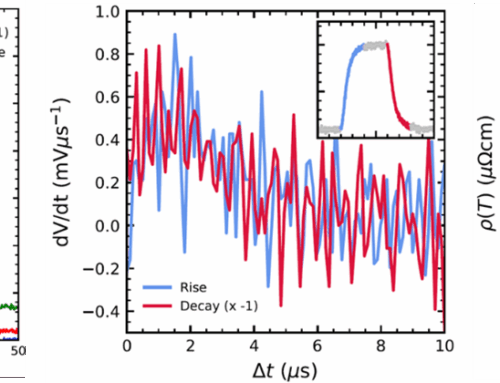Z. Yang, Y. Kohama, ISSP, University of Tokyo, Japan and D. K. Maude, LNCMI Toulouse.
We have investigated quantum oscillations in the electronic specific heat, Cel, in natural graphite. The crossing of a single spin Landau level at the Fermi energy gives rise to a double-peak structure (Figure 1a). Crucially, such a double peak is not observed in other thermodynamic probes. The hole and electron spin Landau levels involved are identified by numerically diagonalizing a Hamiltonian, which describes the band structure of graphite in a magnetic field. At lower temperatures, the splitting decreases, and the double-peak structure disappears below 90 mK (Figure 1b). Intriguingly, the double-peak structure is predicted by text book theory, Cel/T = kB2ʃ D(E) (-x2df/dx) dx where f(x)=1/(1 + ex), x = E/kBT, and kB is the Boltzmann constant. The specific heat depends on the convolution of the Landau-level density of states (DOS), D(E), and a kernel term -x2df/dx, which involves the first derivative of the Fermi-Dirac distribution function. The usual approximation (see textbooks, such as Kittel), removing D(E) from the integral to obtain the well-known formula Cel = π2D(EF) kB2T/3, suppresses the double peak structure which originates from the temperature-dependent splitting of the double maxima in the kernel term (Figure 1c). The calculated and predicted Cel/T are in excellent agreement (Figure 1d), notably they reveal the highly asymmetric DOS of three-dimensional Landau levels due to the van Hove singularity. The kernel term represents a spectroscopic tuning fork of width 4.8kBT, which can be tuned at will to resonance. Using a coincidence method, the double-peak structure in the specific heat can be used to accurately determine the Landé g-factors of quantum materials. More generally, the tuning fork can be used to reveal any peak in the fermionic density of states which crosses the Fermi energy, such as for example Lifshitz transitions in heavy-fermion compounds.

Figure: (a) Electronic specific heat divided by temperature Cel/T in graphite as a function of B, where the 1h spin Landau levels cross the Fermi energy. (b) Magnetic-field position of the double-peak structure as a function of temperature. (c) The kernel term plotted versus E = xkBT. Maxima occur at x = ±2.4 (d) Measured and calculated electronic specific heat Cel/T in graphite close to where the 1e spin Landau levels cross the Fermi energy.
Unveiling the double-peak structure of quantum oscillations in the specific heat, Z. Yang, Y. Kohama, T. Nomura, T. Shitaokoshi, D. K. Maude, B. Fauqué, S. Kim, D. Chowdhury, Z. Pribulova, J. Kacmarcik, D. Aoki, A. Pourret, G. Knebel, T. Klein, and C. Marcenat, Nat. Commun. 14, 7006 (2023)
https://www.nature.com/articles/s41467-023-42730-4
Contact: zhuo.yang@issp.u-tokyo.ac.jp






